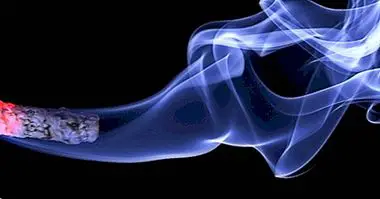Drug abstinence syndrome: its types and symptoms
It is common to hear the expression "be with the monkey" when talking about drug addicts who are experiencing tremors, nervousness or outbursts of anger at a time when they do not have drugs. These are situations in which these people are suffering to a great extent and experience a variable symptomatology. It is a colloquial way of talking about Withdrawal syndrome, problem that we are going to talk about in this article .
- Related article: "Types of drugs: know their characteristics and effects"
What is Abstinence Syndrome?
Abstinence syndrome is understood as the set of symptoms triggered in the body physically and mentally dependent on a substance before the abrupt withdrawal of this one. Said withdrawal may refer to a complete cessation of consumption or to a reduction of this in quantity and / or frequency, and the symptoms are not due to other medical or mental illnesses (although it may exacerbate symptoms of some disease).
Generally the withdrawal of consumption is caused intentionally by the subject with dependence, in order to eliminate the aversive consequences that addiction is causing in his life. They can also occur due to involuntary circumstances in which it is not possible to access the substance in question, such as a hospitalization, a trip or incarceration. A third option is that the subject can not acquire it despite not having the will to stop using it, due to lack of suppliers or the economic capacity to acquire it.
Withdrawal syndrome generates a high level of suffering and discomfort . The specific symptoms of this type of syndrome will depend on the type of substance that is being consumed, being generally the opposite to those that would appear with an intoxication of said substances. Craving or craving and intense cravings for consumption usually appear as a response to the discomfort generated by the absence of substance. Other common symptoms are tremors and spasms, headaches, muscle pain, digestive problems such as nausea and vomiting, dizziness, agitation or hallucinations.
The evolution of the symptomatology and its intensity depend not only on the type of drug but on the type, quantity and frequency of previous consumption, being linked to the level of dependency and addiction presented by the subject. In addition to the drug itself, the problems associated with the withdrawal syndrome will intensify if the cessation of consumption occurs in an environment where it is easy to acquire. Also the way of seeing the world or of perceiving and facing problems will have an effect, having greater discomfort for example inhibited people who do not express their feelings (especially the negative ones).
- Related article: "Delirium tremens: a severe alcohol withdrawal syndrome"
Why is it produced?
The reason for the withdrawal syndrome is something that many people, especially those who suffer from it, wonder. The direct reason is the cessation or sudden reduction of consumption , which has been made in such a way that the body of the subject. The organism has become accustomed to the substance, generating a tolerance to it (which in turn is what causes consumption to increase in quantity and frequency) and the body is accustomed to working with the substance.
The body, balanced before the acquisition of dependence, learns to maintain a new equilibrium in which the drug or substance in question comes into play. The substance, which served as a reinforcer initially, eventually loses some of this role and becomes necessary to avoid the discomfort associated with its lack.
A sudden withdrawal causes the body, which depended on this substance, suddenly to find that it lacks something that made it work. The balance or internal homeostasis that the body had learned to maintain With the drug, he suddenly becomes unbalanced, generating the withdrawal syndrome until he can keep himself balanced. But it depends on how the withdrawal is made, the imbalance can generate very severe repercussions.
- You may be interested: "The reward system of the brain: how does it work?"
The need for a gradual withdrawal
It is important to keep in mind that the withdrawal of the substance should not be done suddenly. And is that although the cessation of consumption in drug addicts is essential and something that can save their lives (both figuratively and literally), suddenly cut the supply of a substance of which our body has dependence can have fatal consequences . The abstinence syndrome is not something to be taken for a joke: it is a dangerous reality that in many cases can have permanent consequences, lead to coma and even lead to death .
In this sense we must take into account the type of drug: it is not the same to disengage from coffee than from cocaine or heroin . Also of the existing dependency level. Withdrawal is necessary, but should be done in a controlled manner (often different drugs are used, for example), patterned and gradual to avoid severe physiological effects and reduce the risk of a withdrawal syndrome dangerous to life.
It is necessary to let the body get used to go running without so much substance to get to work completely without it. Sometimes the use of substitute substances may be necessary , such as methadone, as long as there is no substance consumption but dangerous symptoms are kept in check, hospitalization in detoxification centers or hospitalization of the subject to keep it stable. In some cases, a person has been induced to enter an induced coma to have better control of the situation.
Alcohol, benzodiazepines and opiates are some of the main substances with withdrawal syndromes that could become life threatening, mostly by cardiorespiratory failure . It is therefore necessary to schedule its withdrawal.
Different types of withdrawal syndrome
As we have seen, the type of symptoms will depend to a large extent on the substance, the degree of dependence on it and even the biological characteristics of the dependent person. The following are some of the best-known withdrawal syndromes from those collected by the DSM-5.
1. Tobacco
The withdrawal syndrome caused by tobacco is probably one of the most known and experienced worldwide, being the cessation of consumption something that many consumers have raised. Irritability, insomnia, anxiety, concentration problems, depression and alterations in diet are its main symptoms. It is annoying, but it is one of the least harmful withdrawal syndromes and usually does not present any danger.
- Related article: "The two faces of tobacco dependency (chemical and psychological)"
2. Alcohol
Chronic alcohol users who stop drinking this substance may experience different types of withdrawal syndromes of varying severity. Frequent symptoms are tachycardia and sweating, insomnia, hand tremor s, agitation and anxiety, hallucinations and seizures. In extreme cases it is possible that the subject develops delirium tremens, which can lead the patient to death.
3. Of stimulants
Within this category we include amphetamines, cocaine and other stimulants. Abstinence from these substances generates dysphoric mood, increased appetite, fatigue, nightmares and sleep problems as some of the most well-known symptoms.
4. Sedatives, hypnotics and anxiolytics
The use and dosage and the follow-up of the recommended consumption and withdrawal guidelines avoid this type of withdrawal syndrome, which can be both in those people who use them therapeutically and in those who do it recreationally and / or without control when the consumption of blow is removed. Tremors, autonomic nervous system hyperactivity, tachycardia, nausea and vomiting, hallucinations, agitation and anxiety are some of the most typical symptoms.
5. Of opiates
The sudden withdrawal of opium and its derivatives (such as heroin) generate a withdrawal syndrome with the potential to be fatal. Dysphoria, nausea, pains, diarrhea, fever, insomnia or popular procrastination are some of the usual symptoms in subjects with abstinence from opium derivatives.
6. Cannabis
Cannabis is a substance whose consumption is very popular, especially among young people, and which is perceived as generally innocuous. However, recently there has been described the existence of a withdrawal syndrome that It can occur in subjects who consume daily or almost daily . This syndrome is characterized by restlessness, depression, loss of appetite, nervousness and restlessness and sometimes alterations such as fever, spasms, abdominal pain or headache may arise.
- You may be interested: "Marijuana withdrawal syndrome: symptoms and causes"
7. Caffeine
Although many people can discuss it, the frequent consumption of caffeine in a prolonged way and on a daily basis can generate a certain level of dependence to this substance, as well as abstinence syndrome with its abrupt cessation. Fatigue and sleep, headache, flu symptoms, irritability or dysphoria are typical symptoms of this syndrome.
Bibliographic references:
- American Psychiatric Association. (2013). Diagnostic and Statistical Manual of Mental Disorders. Fifth edition. DSM-V. Masson, Barcelona.



















